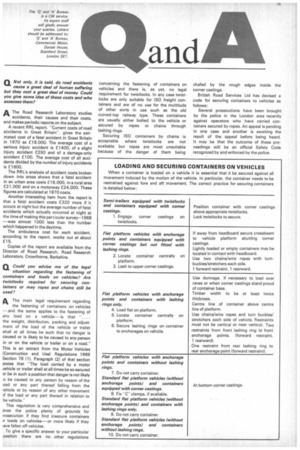Q Could you advise me of the legal
Page 77

If you've noticed an error in this article please click here to report it so we can fix it.
situation regarding the fastening of containers and loads on vehicles? Are twistlocks required for securing containers or may ropes and chains still be used?
AThe main legal requirement regarding
the fastening of containers on vehicles -and the same applies to the fastening of any load on a vehicle— is that ".... the weight, distribution, packing and adjustment of the load of the vehicle or trailer shall at all times be such that no danger is caused or is likely to be caused to any person in or on the vehicle or trailer or on a road." This is an extract from the Motor Vehicles (Construction and Use) Regulations 1969 Section 76 (1). Paragraph (2) of that section states that "The load carried by a motor iehicle or trailer shall at all times be so secured Dr be in such a position that danger is not likely o be caused to any person by reason of the oad or any part thereof falling from the oehicle or by reason of any other movement )f the load or any part thereof in relation to he vehicle."
This regulation is very comprehensive and lives the police plenty of grounds for orosecution if they find insecure containers it. loads on vehicles—or more likely if they lave fallen off vehicles.
To give a specific answer to your particular uestion there are no other regulations concerning the fastening of containers on vehicles and there is, as yet, no legal requirement for twistlocks. In any case twistlocks are only suitable for ISO freight containers and are of no use for the multitude of other sorts in use such as the old curved-top railway type. These containers are usually either bolted to the vehicle or secured by ropes or chains through lashing rings.
Securing ISO containers by chains is acceptable where twistlocks are not available but ropes are most unsuitable because of the danger of them being chafed by the rough edges inside the corner castings.
British Road Services Ltd has devised a code for securing containers to vehicles as follows; Several prosecutions have been brought by the police in the London area recently against operators who have carried containers secured by ropes. An appeal is pending in one case and another is awaiting the result of the appeal before being heard. It may be that the outcome of these proceedings will be an official Safety Code recognized by and enforced by the police.




















































































































